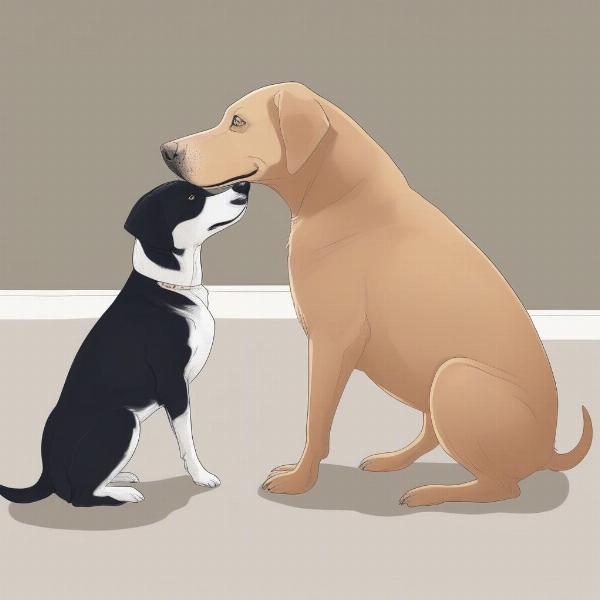Bringing a second dog into your home can be a joyous occasion, doubling the furry love and companionship. However, it’s not always a smooth transition. There are many factors to consider beyond just the initial excitement. What I wish I knew before getting a second dog was how much planning and preparation it truly takes to ensure a harmonious multi-dog household. This article will delve into the key aspects of integrating a new canine companion, offering insights and practical advice to help you navigate this exciting, yet sometimes challenging, experience.
Choosing the Right Second Dog
Introducing a new dog to your resident canine requires careful consideration of personality and temperament. A dog with a similar energy level and play style to your current dog can be beneficial, but it isn’t always a guarantee of compatibility. Consider your current dog’s age, breed, and personality. Are they playful and energetic, or more laid-back and prefer quiet time? Do they have a history of dog aggression or resource guarding? Choosing a dog of the opposite sex can sometimes minimize potential conflicts.
 Choosing a second dog: Breed and temperament considerations
Choosing a second dog: Breed and temperament considerations
Preparing Your Home and Your First Dog
Before your new dog arrives, prepare your home by creating separate spaces for each dog. This allows them to have their own safe havens where they can retreat if they feel overwhelmed. Ensure you have enough resources like food bowls, water bowls, beds, and toys to prevent resource guarding. Start by feeding your current dog in a different location than where you plan to feed the new dog. This helps establish boundaries from the beginning. Engage your current dog in extra training sessions leading up to the arrival of the second dog, reinforcing basic commands and good behavior. This will also help your first dog associate the upcoming change with positive experiences.
The First Introduction: Making it a Positive Experience
The initial meeting between your dogs is crucial. Choose a neutral location outside of your home, like a park or a friend’s yard. Keep both dogs on leashes and allow them to sniff and investigate each other at their own pace. Don’t force interaction. Keep the initial meeting short and sweet, ending it on a positive note. Once you bring them home, supervise their interactions closely, especially during the first few weeks. Separate them when you’re not able to supervise, and gradually increase the time they spend together.
Managing Resources and Preventing Conflicts
Resource guarding, where a dog becomes possessive over food, toys, or even a specific person, is a common issue in multi-dog households. To prevent this, provide separate feeding areas and ensure each dog has their own toys and beds. Avoid giving high-value treats in the presence of both dogs until they have established a comfortable relationship. Supervise them closely during playtime and remove any toys that trigger possessive behavior.
Training and Maintaining Harmony
Continued training is essential for a peaceful multi-dog household. Reinforce basic obedience commands with both dogs individually and together. Teach them to respect each other’s space and boundaries. Consider enrolling them in group obedience classes or seeking guidance from a professional dog trainer experienced in multi-dog dynamics. Consistent training and positive reinforcement will help create a balanced and harmonious environment for all.
Conclusion
Bringing a second dog into your family can be a wonderful experience, but it requires careful planning and ongoing effort. By understanding the dynamics of multi-dog households and taking proactive steps to manage resources, prevent conflicts, and maintain consistent training, you can create a happy and harmonious home for both your canine companions. Remember, patience and understanding are key to a successful transition.
FAQ
-
How do I know if my dog is ready for a second dog? Consider your dog’s temperament, energy levels, and social skills. A dog that is generally well-adjusted, friendly, and enjoys the company of other dogs is a good candidate.
-
What age is best for a second dog? There’s no one-size-fits-all answer, but introducing a younger dog to an older, well-established dog can often be smoother than introducing two similarly aged dogs.
-
How can I prevent food aggression between my dogs? Feed your dogs in separate areas and supervise them during mealtimes. Ensure they each have their own food and water bowls.
-
What if my dogs don’t get along? Seek professional help from a certified dog trainer or behaviorist experienced in multi-dog households. They can provide personalized guidance and help you address specific challenges.
-
How much extra work is a second dog? Expect a significant increase in time commitment for feeding, training, grooming, and exercise. Double the dogs means double the responsibility.
-
What should I do if one dog is bullying the other? Separate the dogs immediately and consult a professional dog trainer or behaviorist to address the underlying issues causing the bullying behavior.
-
How long does it take for two dogs to adjust to each other? It can take anywhere from a few weeks to several months for two dogs to fully adjust to living together. Patience and consistency are crucial during this transition period.
ILM Dog is your trusted international resource for expert dog care advice. We cover a wide range of topics, from breed selection and health care to training, nutrition, grooming, and product recommendations. If you’re considering adding a second dog to your family, our team of experts can help you navigate the process with confidence. Contact us at [email protected] or +44 20-3965-8624 for personalized guidance. Visit ILM Dog for more valuable resources on dog care and companionship.